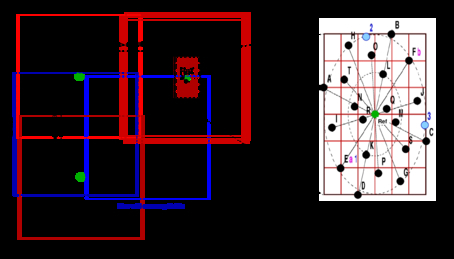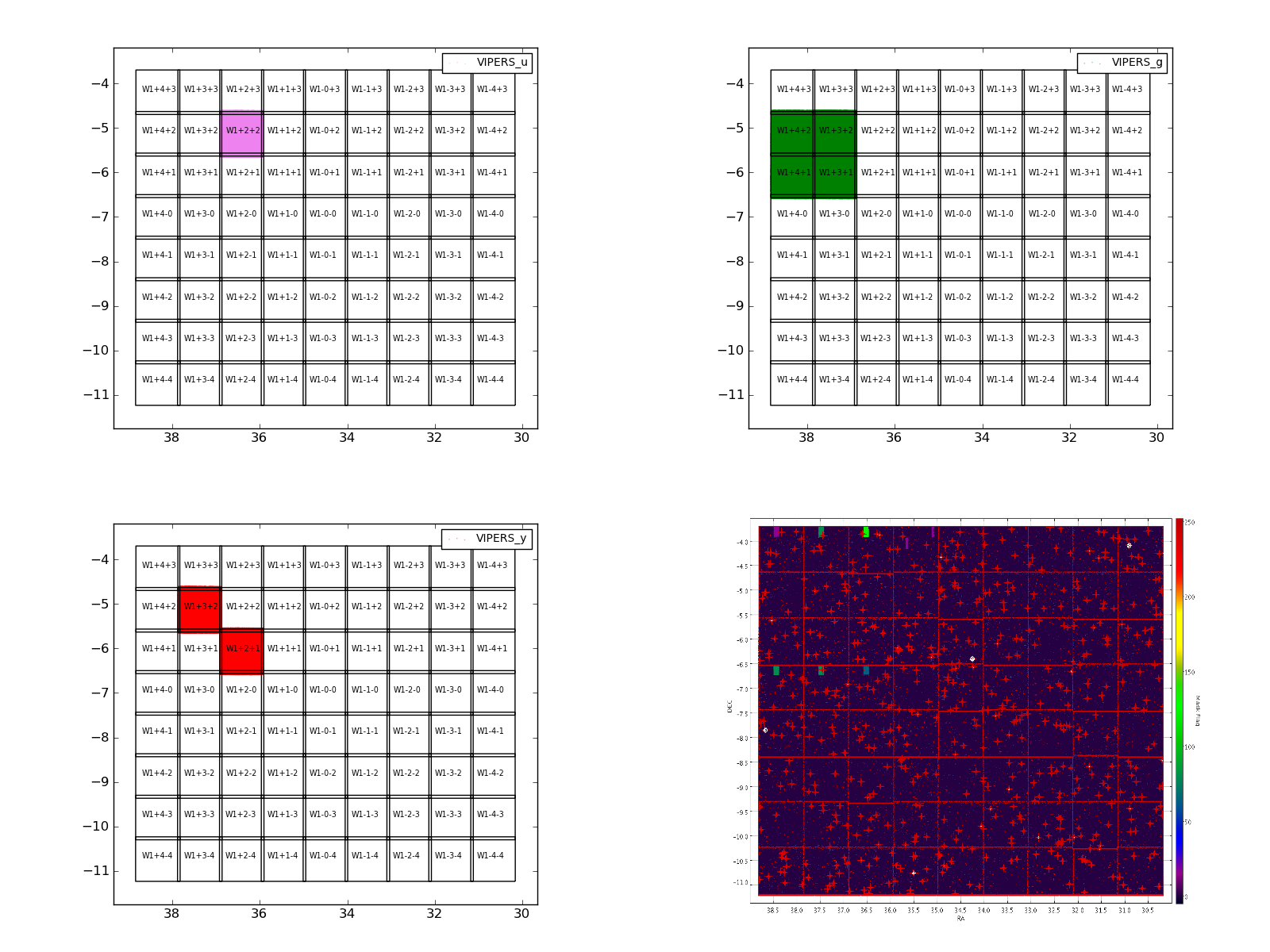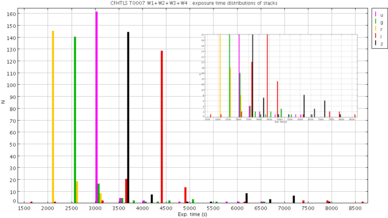The T0007 release of the Wide survey covers 171 MegaCam pointings (or tiles) divided into the W1, W2, W3 and W4 fields and is complete in all filters. In total there are 855 u*,g,r,i∕y and z stacks and 171 chisquared images (2052 including the weight-maps). The positions and geometry of the four Wide fields comprising T0007, namely W1, W2, W3 and W4, are shown on Fig. 19 and summarized in Table 3. Table 6 lists the effective area, after masking, of the four Wide patches in each of the filters.
The image selection criteria applied to the 6378 CFHTLS Validated images for the production of the T0007 CFHTLS Wide survey are the following:
The parent sample of images after the QualityFITS selections is composed of 1000 u*, 1059 g, 1728 r, 1064 i, 291 y and 1236 z-band images. 25% of the sample are short photometric or Pre-Wide exposures that are only used for calibration but are not combined into stacks.
All stacks have the same pixel scale and cover exactly 1×1 deg2 (19354×19354 pixels of 0.1860"). The stacks only combine images that are part of a CFHTLS Wide observing sequence and that are within 3 arcminutes of the CFHTLS pre-defined stack center
|
|
| ||||||||||||||||||||||||||||||||||||||||||||||||||||||||||||||||||||||||||||||||||||||||||||||||||||
|
|
Each stack comprises a sequence of medium exposures a few hundred seconds long each. After each exposure the telescope is shifted by a small amount (typically a few tens of arcseconds, see the right panel of Fig. 21) in order to fill the gaps between CCDs and enable the rejection of bad pixels and cosmic rays during subsequent processing steps.
The adjacent fields have an overlapping region of several arcminutes width to constrain the field-to-field astrometric and photometric calibrations. The size of the overlaps is 4 arcmin in DEC and 3 arcmin in RA (see Fig. 21). The overlaps between fields reduce the sky coverage of the 171 CFHTLS Wide tiles to approximately 155 deg2.

|
Each tile is centered at a well-defined position. The coordinates of a stack center position are identical for all filters. W1, W2, W3 and W4 are therefore composed of a complete set of u*,g,r,i,y and z adjacent square tiles of 1 deg2 each.
The integer part of the center position of each tile is used to name the final stacks and other data products. This naming convention was agreed by CADC, Terapix and the CFHTLS Steering Group and is valid for all CFHTLS releases.
In addition to the official astronomical CFHTLS naming convention, Terapix defined in 2002 a shorter naming convention based on a Cartesian grid coordinate system, where the increment unit is a MegaCam-size field and the center positions of the grid points are the center positions of the tiles21 .
The reference center of each Wide field of view is defined as the reference W![[1,2,3,4]](T0007-doc19x.png) (0,0) and the Cartesian
field names increase toward the East and North. The tiling and field naming conventions are drawn on Fig. 20
and the complete list of the T0007 Wide stacks is given in Tables 30.
(0,0) and the Cartesian
field names increase toward the East and North. The tiling and field naming conventions are drawn on Fig. 20
and the complete list of the T0007 Wide stacks is given in Tables 30.
The total exposure time per filter is approximately the same for each tile (see Table 30 and the synoptic table). For some tiles, the exposure time is longer than the nominal value, because exposures that were considered out of spec by QSO and hence immediately reobserved have been later on salvaged at the post processing time. It produces very sharp exposure time distributions for all filters (see Fig. 23). Some observations have been adjusted to take into account unexpected events (like absorption by clouds/cirrus or technical problems). There are a few fields that have deeper u*-band and z-band exposures which explains the small tails shown in the inset of Fig. 23. These longer exposures were taken before it was decided to cut the u* and z exposure times by a factor of two at the survey mid-term review (2005).
In addition to the original CFHTLS exposures, the VIPERS consortium took complementary exposures to fill in the holes in W1 which were caused by malfunctioning CCDs later in 2003. These images (distributed in 6 pointings and three filters u,g and y) have been added to T0007. As a result, these pointing are deeper than the rest of the survey. A detailed description of the added VIPERS-DDT images can be found in Table 5. Their position on the W1 patch are shown in Figure 22.

|
|
|
All r-band stacks combine data taken during two epochs separated by at least two years and totalling 2×500 s each. In all filters except u*, observations were carried out only when the seeing (FHWM) was below 0.95". For the u*-band, this rule was relaxed to 1.3".
The complete list of CFHTLS input images that were combined into the Wide stacks is given in the Appendix A.2, in Table 31.

|
The global properties of the CFHTLS Wide survey are summarized in Table 4 and in more detail in Table ??. Overall, they meet the survey specifications but the homogeneity of the survey over a Wide patch scale must be assessed carefully. The Wide field-to-field and MegaCam tile-to-tile scatters will be explored in detail in the following sections. The depth, the seeing, the photometric errors analysis are presented in the next parts of the document.
Finally, the complete set of configuration files used for the T0007 release is presented in the Appendix. They are intended for users who would prefer to re-process the pre-processed or the stacked images with parameters tuned for their own scientific projects. The configuration files are available on request from Terapix.
|
|